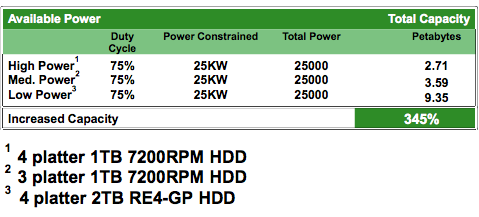Triple your data center’s storage capacity – without increasing power consumption or reducing performance. How?
Going for the green
Everyone talks about green, but in storage arrays it is the power consumption of the disks that dominates. A power-saving blade server buys you almost nothing compared to a few hundred disks.
That’s where WD’s RE4-GP 2TB drive comes in. According to WD the new green power drive performs almost as well as the 1 TB Black drive – Black being WD’s performance series.
The numbers are startling:
With a 25KW power budget you can grow from 2.71 PB of high performance 1 TB drives to 9.35 PB of 2 TB green drives. Likewise you can reduce power consumption for the same capacity by over 2/3rds.
Pretty good.
WD’s Intellipower feature variessets rotational speed of the drive between 5400 and 7200 RPM “depending on what the best solution is for that model.” [Update:WD assures me that their rotational speed does not change. End update.] There’s a performance hit versus always full speed drives of course, but if power and cooling is an issue the modest tradeoff could be worth it.
Not entirely free
The new drive offers not only greater density – 500 GB per platter vs 333 for the older 1 TB – but also dual processors and a 64 MB cache. There are probably other optimizations in the drive electronics.
An OEM who is qual’ing the drives confirmed WD’s claim. Twice the capacity on a much lower power budget, with a 1.2 million hour MTBF and a 5 year warranty.
Of course, you’ll also cut your IOPS/TB in half. But if that is a critical success factor you’re probably not using 7200 RPM drives.
WD also plans to move into enterprise drives. They have a nice start with the 10k VelociRaptor, which is the system disk on the StorageMojo mainframe and a snappy performer. A nice upgrade from a 7200 RPM drive because it makes everything noticeably faster.
The StorageMojo take
As a marketing term of art, “green” is much abused. WD has hit upon a persuasive way to present the benefits of the underlying technology – and they deliver the goods.
Reducing power consumption will be a continuing trend as more data resides on disk. This helps disks compete against SSDs on the high end and tape on the low-end.
As Moore’s Law continues to drive micro-controller performance higher more clever – but compute intensive – optimizations will be implemented. WD seems to have the lead in the power arena today.
Power constrained data center managers everywhere will thank them.
Courteous comments welcome, of course. Update: Stephen Foskett alerted me to the fact that the GP drives do NOT have a variable speed, and WD’s crack PR team – she never sleeps! – informed me that each drive model has a constant RPM depending the drive’s intended application. OK, whatever. End update.



Although I am as enthusiastic as you about this great drive series, WD has clarified that they do not vary the spindle speed. Although a variable-speed drive would be cool, this would be a very tricky feat to manage for not much benefit. WD doesn’t say what speed the drive does spin at, but acoustic tests show that it’s just plain old 5400 rpm.
Also, note that the RE4-GP is very similar to the existing (consumer) WD20EADS, according to Tom’s Hardware.
Stephen, for some reason the data sheet doesn’t give the RPM either, preferring to reference “Intellipower.
OK WD’ers, what is the answer?
Robin
The comparisons are against 7200 rpm drives. The only thing power savings is the lower RPM. Would be interesting to compare against 5400 RPM drives as well.
While not widespread or commonly deployed particularly in enterprise storage arrays, as to Steves point about variable speed disk drives, you might want to check with HGST as I recall them having a drive that can change its RPM from 5400 to 4000 or so RPMs as part of an energy saving mode.
Is changing the RPM tricky, perhaps that why most are not doing it yet. However looking at disk drives and where they are saving power, sure RPM has a play actually something’s needs to keep the “flywheel spinning” once it’s up to speed (hence initial surge), however so to do turning off r/w heads or other circuitry that consumes power.
Here’s a link to some material looking at intelligent power management (IPM) and variable drive power savings, something we should be hearing more about in the not so distant future to overcome 1st generation MAID or drive spin down woes.
http://storageio.com/Reports/StorageIO_WP_Jan02_2008.pdf
Cheers gs
Ok…I need some help here.
It takes 3.7 watts to keep the “GreenPower” disk spinning (at it’s lowest speed). But it only takes 0.85w to keep WD’s Scorpio Blue 1TB laptop disk spinning. That’s less than half as much power-per-GByte for WD’s laptop SATA disk vs. desktop SATA.
When the 2TB “GreenPower” disk is in “standby” mode (completely spun down), it is still using as much power (0.8W) as the laptop disk does when spinning at full speed.
What sense does it make to invest in MAID or related technology for managing spinning-disk related power consumption when all you have to do is switch to laptop disks and achieve more-than-equivalent power savings — without having to ever spin down?
Why don’t we ever hear disk drive manufacturers talk about the fact that laptop disks use only a small fraction of the power-per-GByte of desktop disks?
Anon, that’s what Atrato did (not that you’d know it from their site, but I digress). However, you have to consider that 2.5″ disks are more expensive per GB than 3.5″, so you have to calculate whether the power savings is large enough to compensate for the extra disk cost.